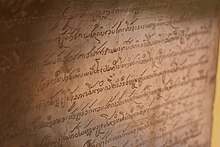Tai Noi script
| Tai Noi Lao Buhan | |
|---|---|
 | |
| Script type | |
Time period | c. 1500 Tai Yo |
[a] The Semitic origin of the Brahmic scripts is not universally agreed upon. | |
| Brahmic scripts |
|---|
| The Brahmi script and its descendants |
The Tai Noi (also spelled Thai Noi) or Lao Buhan script is a
Names
The Tai Noi script (
History
The Tai Noi/Lao script and the Thai script derive from a common ancestral Tai script of what is now northern Thailand which was an adaptation of the
The 16th century would see the establishment of many of the hallmarks of the contemporary Lao language. Scribes abandoned the use of written Khmer or Lao written in the Khmer alphabet, adopting a simplified, cursive form of the script now known in Thailand as Tai Noi.

The use of the script was banned in Isan in 1871 by royal decree and supplemented with the Thai alphabet, followed by reforms that imposed Thai as the administrative language of the region in 1898, but these edicts had little impact as education was done informally by village monks. The written language survived to some degree until the imposition of the radical Thaification policies of the 1930s, as the Central Thai culture was elevated as the national standard and all expressions of regional and minority culture were brutally suppressed.[7] Many documents were confiscated and burned, religious literature was replaced by royally sanctioned Thai versions and schools, where only the Thai spoken and written language was used, were built in the region. As a result, only a handful of people, such as academic experts, monks that maintain the temple libraries and some elderly people of advanced age are familiar with and can read material written in Tai Noi script. This has led to Isan being mainly a spoken language, and when it is written, if at all, it is written in the Thai script and spelling conventions that distance it from its Lao origins.[4]

In Laos, Tai Noi survives with a few modifications as the
Characteristics
The Tai Noi consonants are written horizontally from left to right, while vowels are written in front, on top, at the bottom, and after the letter, depending on the vowel. The script does not have capital or lowercase letters. There are no spaces between words. Sentences are ended with a space.
The Tai Noi script has its own numbers, which are similar to numbers found in the Lao script.
Consonants
The Tai Noi script contains 27 initial consonants.
Consonant clusters
Consonant clusters are initial consonants that consist of two consonant letters combined into one letter.[12]
The following picture illustrates some examples:
Final consonants
The Tai Noi script contains letters specifically for consonants in the final position of a word. There are 11 final consonant letters in total for 8 different sounds.
Vowels
The Tai Noi script contains 29 vowels formed by numerous diacritics.
Unicode
Attempts to encode Tai Noi in Unicode have been made.[5]
Fonts
You can download a Tai Noi font at the IsanGate website.[13]
References
- ^ a b c d Lorrillard, Michel (2005). "The Diffusion of Lao Scripts". The Literary Heritage of Laos: Preservation, Dissemination, Research Perspectives (Collected Papers in Lao, Thai and English from the International Conference in Vientiane, 8–10 January 2004). Vientiane: The National Library of Laos. pp. 366–372.
- ^ a b c d Phra Ariyuwat (1996). Phya Khankhaak, the Toad King: A Translation of an Isan Fertility Myth in Verse. Translated by Wajuppa Tossa. Lewisburg, PA: Bucknell University Press. pp. 27–34.
- .
- ^ a b c d e f Ronnakiat, Nantana (1992). "Evidence of the Tai Noi Alphabet Found in Inscriptions" (PDF). The Third International Symposium on Language and Linguistics. Bangkok: Chulalongkorn University. pp. 1326–1334.
- ^ a b Mitchell, Ben (2018). "Towards a Comprehensive Proposal for Thai Noi/lao Buhan Script" (PDF) – via Unicode.org.
- ^ Keyes, Charles (2003). "The Politics of Language in Thailand and Laos". In Fighting Words: Language Policy and Ethnic Relations in Asia, ed. By Michael e. Brown and Šumit Ganguly. Cambridge, Ma: The mit Press, Pp. 177-210. Retrieved 19 April 2022.
- ^ Draper, John (2013). "Introducing Multilingual Thai – Isan – English Signage in a Thai University" (PDF). Journal of Lao Studies. 4 (1): 11–42.
- ^ "The Constitution of the Lao People's Democratic Republic". Archived from the original on 2011-08-06 – via un.int.
- ^ Draper, John (2004). "Isan: The Planning Context for Language Maintenance and Revitalization". Second Language Learning & Teaching. 4.
- S2CID 145264735.
- JSTOR 44668412.
- ^ "First Revised Proposal Transliteration of Akson-Tham-Isan and Akson-Thai-Noi" (PDF) – via eki.ee.
- ^ "อักษรไทยน้อย - IsanGate : ประตูสู่อีสานบ้านเฮา".




